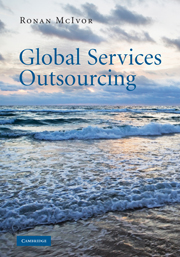Book contents
- Frontmatter
- Contents
- List of figures
- List of tables
- List of illustrations
- Acknowledgements
- 1 Introduction
- 2 Global services outsourcing overview
- 3 Making the services outsourcing decision
- 4 Location and sourcing model choice in global services outsourcing
- 5 Managing global services outsourcing arrangements
- 6 Creating shared services arrangements
- 7 Services outsourcing and performance management
- 8 Services outsourcing and the spin-off arrangement
- 9 Learning from failure and strategies for recovery in business process outsourcing
- 10 Conclusion
- Glossary
- Index
- References
4 - Location and sourcing model choice in global services outsourcing
Published online by Cambridge University Press: 05 June 2012
- Frontmatter
- Contents
- List of figures
- List of tables
- List of illustrations
- Acknowledgements
- 1 Introduction
- 2 Global services outsourcing overview
- 3 Making the services outsourcing decision
- 4 Location and sourcing model choice in global services outsourcing
- 5 Managing global services outsourcing arrangements
- 6 Creating shared services arrangements
- 7 Services outsourcing and performance management
- 8 Services outsourcing and the spin-off arrangement
- 9 Learning from failure and strategies for recovery in business process outsourcing
- 10 Conclusion
- Glossary
- Index
- References
Summary
Introduction
The conventional view of location choice is that it involves a comparison of the relative advantages of a number of locations, with labour costs being the dominant criterion. Outsourcing can be a very attractive option, with labour cost differentials between developed economies and emerging economies as high as 60 per cent. Senior executives transfer IT and HR tasks and processes to lower-cost locations, and expect cost savings to mirror closely those of the perceived labour differentials. However, some executives have been disappointed with the savings, and seen labour costs and labour turnover rise in some locations. These experiences are primarily driven by insufficient analysis, and a lack of understanding of the dynamics of the location decision. The attractiveness of some locations in terms of labour costs can diminish as increasing demand for services drives up the cost of labour and leads to skills shortages. In addition, some companies in the USA and UK have chosen India as their preferred location for services outsourcing, following the lead of competitors, rather than understanding the underlying factors that influence its attractiveness both currently and in the future.
The emphasis on costs means that insufficient emphasis is placed on factors such as language, culture and geographical differences. These factors have proved to be significant barriers to managing global services operations effectively. Cultural and geographic distance hinders communication and the development of trust between the client and vendor.
- Type
- Chapter
- Information
- Global Services Outsourcing , pp. 79 - 113Publisher: Cambridge University PressPrint publication year: 2010



